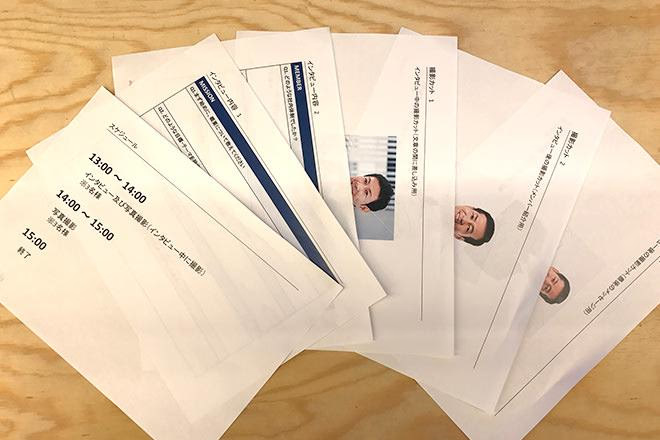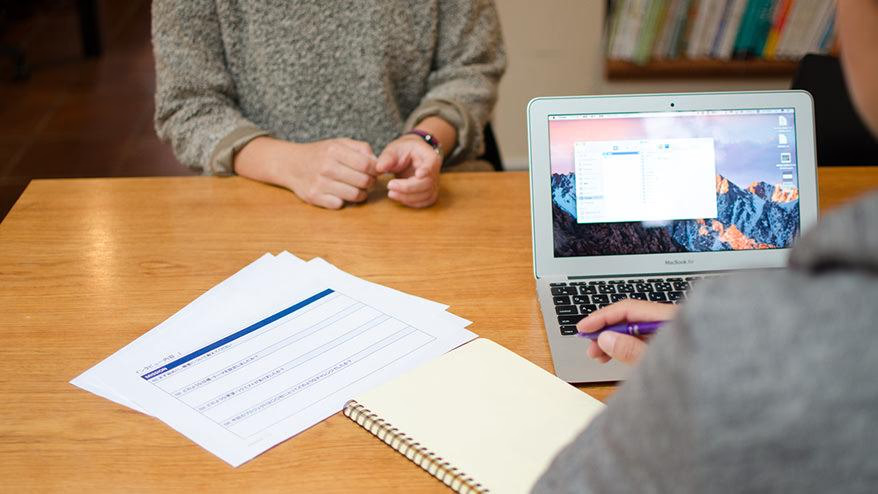こんにちは、ディレクターの大藪です。
私は主に、BtoB企業のコーポレートサイト制作を担当していますが、コーポレートサイトの制作においても、写真撮影やライティング、いわゆる「取材」を行うことがあります。
原稿や写真は、基本的にクライアントにご用意いただくことが多いのですが、「採用サイトにいい表情の社員をのせたい」「読み応えのあるプロジェクトストーリーをつくりたい」など、クライアントからご要望を受けた場合は、取材を行います。
撮影やインタビューなどはプロの方に依頼しますが、ディレクターが果たすべき役割も、もちろんあります。今回は、私が思う「取材時のディレクターの役割」についてお話ししたいと思います。
コーポレートサイトで取材が必要なのは?
コーポレートサイトで取材が必要になるものは、主に、以下のページやコンテンツです。
TOPメイン画像の写真撮影
TOPページはサイトの入り口で一番初めに目が行く箇所なので、クライアントから撮影依頼を受けることがよくあります。
オフィスの外観、社員さんの写真などがおもな撮影内容です。
読み物コンテンツページのライティングや写真撮影
代表的なのが、プロジェクトストーリーです。
企業の実績をひとつのストーリーとして見せるために、インタビューを行います。また、インタビュー時の様子を撮影して、写真を掲載することもあります。
1. クライアントと取材内容をつめる
まずはじめに、原稿や写真をどんな内容にするか、クライアントとつめていきます。

社員紹介ページのワイヤーフレームの一部
取材内容を決めるため、見出し、文章、写真の構図など、ワイヤーフレームの段階でイメージを入れておきます。
写真撮影について
実際のデザインデータをベースに、クライアントと撮影する内容を決めていきます。
撮影する部分は仮の素材写真、絵コンテなどで代用しておきますが、実際の撮影内容に沿った写真を使うことで、最終的な形がイメージしやすいようにしておきます。
そういったイメージをもとに、クライアントの要望を聞きながら、どんなシーンを撮影するのか、撮影場所、人のイメージ(人数、性別、年齢層、服装、表情)、構図(アップ、引き)など、細かくつめていきます。
原稿について
プロジェクトストーリーや社員インタビューなど、実際にどんなページになるのかイメージしやすいように、内容に合わせたワイヤーフレームを作成し、それをもとに詳細をつめていきます。
どんな内容にするのか(インタビューのポイント)、原稿の大枠(概要や文章の見出し)、各段落の文字数などが決まるとレイアウトが確定するので、詳細部分をダミーにしたままデザインデータを起こします。
このように、できるだけ完成に近い形をクライアントと制作側(カメラマン・ライター含む)の全員で共有することで、認識のズレを防ぐことができ、最終的なクオリティーアップにもつながります。
2. カメラマン・ライターと詳細をつめる
クライアントと取材内容をつめたら、カメラマン・ライターと当日に向けた準備を進めます。
撮影のロケハン
撮影がある場合は、カメラマンと撮影場所のロケハンを行います。
室内の撮影では、光の入り方を確認しながら撮影する角度を決めたり、屋外の撮影では、背景に何を入れるのかを決めていきます。
実際、当日現場に行ってみると、もともとイメージしていたような写真が撮れない、なんてことはよくあるので、事前に現場の確認を行うことは重要です。カメラマンと相談しながらロケハンを行うことで、当日撮影すべきイメージをしっかりつかむことができます。
インタビュー内容の設計
クライアントとつめた大枠の内容をもとに、ライターとインタビュー内容を決めていきます。どんな質問をすれば期待する話が引き出せるのか相談しながら、一つ一つ質問事項を決めていきます。
質問事項が決まったら、事前にクライアント(回答者)に共有します。事前に知ってもらうことで、回答者はインタビュー時のイメージができるため、当日スムーズに話ができるようになります。
取材場所・当日スケジュールの共有
カメラマン・ライターに、取材現場の住所および現地までの交通手段を伝えます。
車で移動する場合は、あらかじめ現場近くの駐車場も確認しておきます。
また、当日のスケジュール(集合する場所と時間、何時から何時までどのカットの撮影やインタビューを行うか等)を伝えます。1日で数回取材を行う場合もあるので、現場から次の現場までの移動時間も調べて共有しておきます。

カメラマン、ライターと共有する事前資料
取材日時、現場住所や最寄り駅、取材内容、撮影写真の構図、当日時間割りを記載します。
その他の準備
外で撮影を行う場合は数日前から当日の天気をチェックしたり、取材予定場所の使用許可の有無を確認して、必要な場合は手続きしておきます。
その他、何が起きても早めに予定変更や調整ができるよう手段を考えておきます。
取材については、入念に準備していても、当日想定外のことが起こって取材不可になる、なんてことも十分ありえます。(経験したことは無いですが…)
そんな事態にならないよう、何が必要か、どんなことが起こり得るかなど、事前準備は時間をかけて慎重に行うよう心がけています。
3. 取材当日の対応
取材当日は、クライアントとの情報共有をはじめ、撮影やインタビュー時のフォローを細かく行います。

取材当日、クライアント・制作側で共有する資料
今日の時間割り、インタビュー内容、写真撮影の構図や枚数を記載しています。
クライアントと「取材のゴール」を共有する
当日は取材を開始する前に、クライアント(担当者・取材を受けていただく方)と情報共有する時間を設けます。今日の取材意図・内容を伝えて、実際のページデザインをお見せしならがら、取材する側/される側で同じゴールを共有できるよう説明を行います。
これによって、取材を受けていただく方も「最終的な形」がイメージできるため、高いモチベーションで取材を進めることができます。
カメラマンの撮影をフォローする
人物を撮影する場合、カメラマンは相手と雰囲気を作ることに集中しているので、それ以外にフォローできることを細かく行っていきます。
撮影し終わった写真をチェックして次のカットの指示を行ったり、撮影される方が汗をかかないよう空調を調整したり。また、インタビュー時の撮影では、話している方の目線が下がりがちなので、目線を上げてもらうよう声をかけたりもします。
インタビューの進行をフォローする
インタビュー時は、必要な質問が漏れていないか、質問に対して十分な回答をいただけているかなど、確認を行っていきます。
取材を受ける方はインタビュー慣れしてない方が多いので、質問に対する回答が長くなり過ぎてしまったり、話がそれてしまうこともあります。そのような場合は、時間配分を考えて、時間内に最後までインタビューを行えるよう、ディレクターから指示を入れることもあります。
基本的に、撮影・インタビューの技術的な部分についてはプロの方にお任せしていますが、Webサイトへ落とし込まれた時のことを考え、必要に応じて指示を行うこと、限られた時間内で取材を行えるように進行することが、取材時のディレクターの役割だと思っています。
また、カメラマン、ライターに最大限の力を発揮してもらえるように、できる限りのフォローを行うことも、ディレクターの大事な役割だと思います。
まとめ
取材時は多くの担当者が関わり、当日の時間も限られ、やり直しがきかないことがほとんどです。
クライアントや取材を受ける方、制作側で取材の目的を事前にしっかり共有し、最終的にどのような形になるのか認識を合わせること、取材を行うために必要なことを全て洗い出して、想定外のことが起こらないよう、しっかり事前準備を行うことが取材案件の基本だと思います。
取材は一発勝負! 的な面もあるため、時にやり過ぎと思われてしまうほど準備を行ってしまうこともありますが、結果的にそれが良いアウトプットに繋がっているのかなと、自分自身では思っています。
時間をかけて提案して準備した分、本番のサイトがアップされた時は、やはり喜びも一味違いますね。

